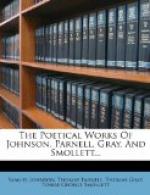[Footnote 12: ‘Battle bray:’ ruinous civil wars of York and Lancaster.]
[Footnote 13: ‘Towers of Julius:’ Henry VI., George Duke of Clarence, Edward V., Richard Duke of York, &c., believed to be murdered secretly in the Tower of London; the oldest part of that structure is vulgarly attributed to Julius Caesar.]
[Footnote 14: ‘Consort:’ Margaret of Anjou.]
[Footnote 15: ‘Father:’ Henry V.]
[Footnote 16: ‘Usurper:’ Henry VI., very near being canonised; the line of Lancaster had no right of inheritance to the crown.]
[Footnote 17: ‘Rose of snow:’ the White and Red Roses, devices of York and Lancaster.]
[Footnote 18: ‘Boar:’ the silver Boar was the badge of Richard III., whence he was usually known in his own time by the name of The Boar.]
[Footnote 19: ‘Half of thy heart:’ Eleanor of Castile, Edward’s wife, died a few years after the conquest of Wales.]
[Footnote 20: ‘Long-lost Arthur:’ it was the common belief of the Welsh nation, that King Arthur was still alive in Fairyland, and should return again to reign over Britain.]
[Footnote 21: ‘Genuine kings:’ both Merlin and Taliessin had prophesied that the Welsh should regain their sovereignty over this island, which seemed to be accomplished in the House of Tudor.]
[Footnote 22; ‘Awe-commanding face:’ Queen Elizabeth.]
[Footnote 23: ‘Taliessin:’ chief of the Bards, flourished in the sixth century; his works are still preserved, and his memory held in high veneration, among his countrymen.]
[Footnote 24: ‘A voice:’ Milton.]
[Footnote 25: ‘Warblings:’ the succession of poets after Milton’s time.]
* * * * *
VII.—THE FATAL SISTERS.
FROM THE NORSE TONGUE.[1]
’Vitt er orpit
Fyrir valfalli.’
ADVERTISEMENT.—The author once had thoughts (in concert with a friend) of giving a history of English poetry. In the introduction to it he meant to have produced some specimens of the style that reigned in ancient times among the neighbouring nations, or those who had subdued the greater part of this island, and were our progenitors: the following three imitations made a part of them. He afterwards dropped his design; especially after he had heard that it was already in the hands of a person[2] well qualified to do it justice both by his taste and his researches into antiquity.
PREFACE.—In the eleventh century, Sigurd, Earl of the Orkney Islands, went with a fleet of ships, and a considerable body of troops, into Ireland, to the assistance of Sigtryg with the Silken Beard, who was then making war on his father-in-law, Brian, King of Dublin. The Earl and all his forces were cut to pieces, and Sigtryg was in danger of a total defeat; but the enemy had a greater loss by the death of Brian, their king, who fell in the action. On Christmas-day




